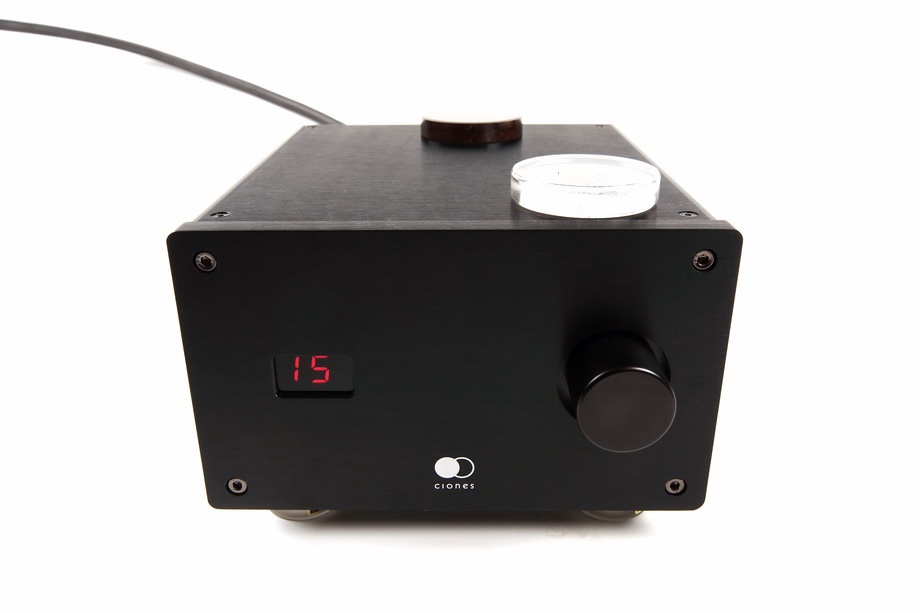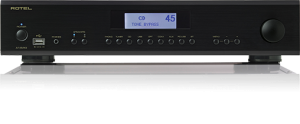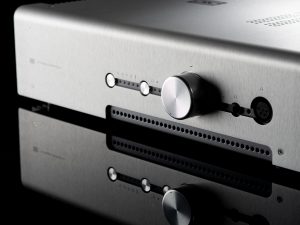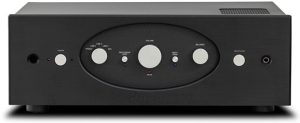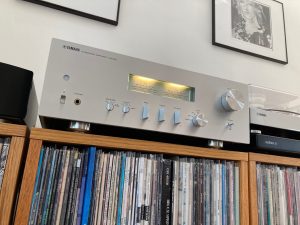Funjoe, the owner of CLONES audio, left his well paid job of a graphic designer to take on his life's true passion—audio. He is not the first as there were others before him like Silvio Pereira of Audiopax to name one, and he won't be the last, but surely he is among few who made such decision at some point of their carriers. One has to have a lot of resolve and confidence in one's abilities to make such choice. Support from family and friends comes handy too.
The latter factor is particularly important because changing a well paid job for an uncertainty of an own business usually means lower income, at least for some time. Funjoe, living in Hong Kong made this tough choice and five days after his son was born, on Dec. 12th 2012 he founded CLONES audio. He dreamed about making his own products but he also wanted to show his son that persistence and hard work do make dreams come true.
His products originate from the DIY (Do-It-Yourself) part of audio world. Once popular all over the world, including Poland, today it seems to loose its momentum, at least in our part of the world. But as you could read in Mark Robinson's text, in Japan, and in Asia in general, DIY is still alive and well. People design and build their own devices, experiment, have fun. Most of them never even consider transforming their DIY activity into commercial one simply because it requires something more than just designing skills—one has to become a manager too and has to be able to invest a lot of time and money before succeeding.
25iR
One of the key advantages of DIY products is their affordable price and thus a great price/performance ratio. But to start to sell the product one has to consider additional costs: professional chassis, safety certificates and a profit margin. The latter might be minimized with direct sales, and that's what CLONES audio does. But there is no way around the former two.
Even more so in this particular case, as Funjoe's chassis is a well thought-trough and really solid; you won't find this level of precision and quality in audio products from below 10000 PLN price range and even some more expensive ones might not match the level either. But in this case it is possible because, the 25iR is a tiny device—place a mini LP type CD on top of it and it will (almost) cover it all. Chassis is quite 'tall' though, which allowed designer to fit all electronic circuits inside. Black, anodized aluminum plates bolted together create a solid, vibration-resistant structure. They also act as radiators which is another cost and size reducing factor.
It is not the first CLONES audio product review in High Fidelity. In 2013 we reviewed the 25i integrated amplifier. It was actually Funjoe's first product, a direct 'translation' of his DIY experience to a commercial use of it. It's design was based on gainclone project, a clone of 47labs' Gaincart amp, he had built few years earlier for his father. This amplifier featured one LM3875 chip per channel. Signal's path was extremely short, power supply pretty decent.

The new version features a different front panel and a remote control. This time the name of the device includes information about its output (for 8 Ω)—25 W but also a letter 'R' that indicates that it is remotely controllable. It would seem that it is only slightly changed design. I asked Funjoe about and it seemed that I wasn't the only one asking this kind of question:
Most of the people think it just simply add the remote to the 25i. But as your seen the layout is huge difference. I tried to put all things into the same tiny box with the individual power of each section to push all things to the best it ever can.
The difference of the 25i and IR as following:
- The improved version of the awards 25i.
- PGA2311 as the input and volume section with no gain.
- Power for the MCU and PGA2311 are individual.
- The MCU is placed alone with the display section to make the noise as low as possible.
- The redesigned layout of the chassis is one of the most important part for the sound tuning. It cost double to the old one!
You can find that there have quite difference character of the tone and the performance even the 25i and iR both are the no gain preamp. The volume section is kind like the goal keeper of the input. So that's why it is so important.
TEST METHOD
I placed amplifier on Audio Replas anti-vibration insulators and on the Acoustic Revive RT-38H platform. For this test I used a full set of Tellurium Q Silver Diamond cables—interconnect, speaker cable and power cable.
I used few different sources and loudspeakers and compared it to some other amplifiers. Apart from my standard reference system I compared it also to Norma Audio set with SC-2 preamplifier and IP-150 power amp. 25IR drove not only my own Harbeth M40.1, but also high-efficiency tube speakers—Blumenhofer Fun 10 and tiny, closed-box Chartwell LS3/5. As for sources I used my Ancient Audio Lektor AIR V edition CD Player, but also Chord Dave D/A Converter. CLONES audio participated also in my test of Verictum X Fuse. It sounded really good in each and every of those setups, it never sounded poorly, nor even just OK—always really, really good.
SOUND
Recordings used for the test (a selection)
- The Stockfish DMM-CD/SACD vol. 2, SFR 357.5902.2, SACD/CD (2016)
- Billie Holiday, Body and Soul, PolyGram/Mobile Fidelity UDCD 658, gold-CD (1957/1996)
- Chet Baker, Chet Baker sings and plays, Pacific Jazz/EMI Music Japan TOCJ-90028, HQCD (1955/2006)
- Ella Fitzgerald & Louis Armstrong, Ella and Louis, Verve/Lasting Impression Music LIM UHD 045, UltraHD CD (1956/2010)
- Fleetwood Mac, Tusk, Warner Bros. Records/Warner Music Japan WPCR-17017/9, 3 x SHM-CD (1973/2015)
- Frank Sinatra, Lost & Found | The Radio Years, Sony Music 8875147142, CD (2015); review HERE
- Frank Sinatra, Sinatra Sings Gershwin, Columbia/Legacy/Sony Music Entertainment 507878 2, CD (2003)
- Jamie xx, In Colour, Young Turks/Hostess YTCD122J, CD (2015/2016)
- John Coltrane, Coltrane's Sound, Atlantic/Rhino R2 75588, "Atlantic Jazz Gallery", CD (1964/1999)
- The Modern Jazz Quartet, Pyramid, Atlantic Records/Warner Music Japan WPCR-25125, "Atlantic 60th", CD (1960/2006)
Unfortunately I had no chance for head-to-head comparison with previous version but since my reference system remained unchanged and I remembered also very well my impressions from the first test of CLONES audio I decided to write a few words about what, as I remember it, changed compared to the older version. To be honest I'm not sure if it really makes sense. Why? Because it is the same amplifier, offering a bit better performance but sharing the same DNA with its predecessor. Yes, it offers more precise, more resolving sound. These improvements, if memory serves, are quite significant only if one searches for some progress, for a better sound. But if one just wants a great sounding, inexpensive amplifier and already has previous version, one should keep it and enjoy it for many more years. Replacing original version with new one makes sense only if you absolute need some change. The Model '25' was from the very beginning a very good one and if you have it already you can keep enjoying it.
Just like its predecessor, 25iR offers a certain, clear vision of sound. Surely there are many other, offering even better performance, but also more expensive amplifiers, and yet 25iR stands out among them because when you start listening to it in your system you don't feel any discomfort, any need to replace it with one of these better/more expensive competitors. Whatever speakers will be connected to it, combined performance will be rich, saturated and thus particularly interesting. This amplifier did a great job differentiating recordings, presenting a different approach to music recording used for Chet Baker's Chet Baker sings and plays and Ella Fitzgerald with Louis Armstrong's Ella and Louis album. It clearly pronounced differences between timbre, frequency range and dynamics. What's particularly interesting, it was able to show those differences not only in midrange and treble, but also in bass.
It was a real volcano of energy, so to speak. Remaining in full control of the events it dealt really well with lowest, densest tones on Jamie xx's album, filling room with an almost palpably dense sounds with each of them being 'electrically charged'. Usually this type of bass is described as 'natural' as it features a slightly soft leading edge. CLONES audio offered powerful, dense, well extended bass but with a 'natural suspension' right after attack phase. To perform it this way amplifier needs a very good control over drivers coming from high current efficiency and low output impedance. I can't tell you if it is so with this amplifier, but from what I could hear it performed better then most competitors from up to 10.000 PLN price range.
This type of bass presentation complements nicely midrange and treble. When I compared Funjoe's product with two high-end amplifiers—Ayon Audio Spheris III + Soulution 710 and Norma Audio SC-2 + IP-150—I found out that tonal balance of 25iR was shifted towards lower midrange and it was surely not as resolving as reference sets. But such comparison made sense only because without such reference 25iR seemed particularly resolving and I was asking myself whether it would really make sense to spend more for a high end system? Maybe it would be better to keep it and spend the price difference for thousands of CDs/records?
I'm not sure how to answer that question myself and that's why I spent a lot of time comparing head-to-head how resolving this amplifiers were. As for 25iR—it is resolving, all right, but not 'high-end resolving'. Due to very good selectivity and amazing richness of the sound performance seems complete, like nothing is missing. So if we take resolution into consideration one has to pay more, much more to be fully satisfied. But considering price/performance ration resolution is fantastic.
And there is this staggering dynamics! This is an 'Achilles heel' of most 'audiophile' amplifiers, including tube ones. In the name of proper balance throughout the whole rich, dense range energy is being 'trimmed'—either to keep treble from being too aggressive, or bass from being to edgy. To be clear—I understand that such compromises are sometimes necessary and I accept them. I think that they allow listeners to enjoy music in a deeper, more refined way as compared to a situation where these compromised wouldn't have been made. The point is—the amplifier under review has no need for such trade-offs. CLONES audio offers both—dynamics and rich tonality, richness and rhythm.
Summary
This tiny amp from Hong Kong is available only directly from manufacturer, which limits numbers of potential buyers. 5-year warranty plus knowing that a really upstanding guy is behind that product are surely its advantages. Some might still hesitate because it can be bought only directly from manufacturer. I think that there is nothing to be afraid of. I saw Funjoe's amplifiers in systems, where every single cable was more expensive than the amp—that also happened in my own setup. And it wasn't a mismatch. I felt that 25iR simply belonged there. So what about its price? Let's treat it a a joke, as a gift from a man with a golden heart who quit his well paid job to be able to offer such gifts to the people. If that's his dream come true—I wish to every one of us that we could realize our dreams in such a wonderful way.
DESIGN
Model 25iR is an integrated amplifier made by CLONES audio from Hong Kong. It is a tiny cube measuring 170 x 100 x 170 mm (W x H x D). It might be tiny but it looks impressive. It features three RCA inputs, two pairs of speaker outputs, and an output power of 2 x 25 W @ 8 Ω. Compared to its predecessor it sports a different volume control and thus its input impedance changed—instead of 33 kΩ now it is only 10 kΩ. It is not a particularly high value but except for tube sources with high output impedance or some exotic solutions without output buffers, it should be more then enough. Unlike previous version, 25iR features a remote control—a small, handy, aluminum one with small push-buttons. It is a typical Chinese product—it is quite solid but not particularly beautiful.
Front it different than the one used for previous models. Instead of two knobs—volume control and input selector—there is only one, that allows to adjust volume control and, when pushed, choose an input. Next to it there is a red LED display. It delivers information about volume level and, for a few seconds, a selected input. An interesting fact—this display is on also when an on/off on rear panel is set to 'off' position. It might suggest that controller and input section are actually always on.
Rear panel features 3 pairs of analogue RCA inputs. These sport high quality CMC-816U sockets made by American company CMC (Charming Music Conductor). There are no analogue outputs, only double speaker posts and a IEC socket integrated with a fuse and a mechanical on/off switch (green backlit).
The chassis is composed of well fitted aluminum plates. It sits on three feet—two of them are placed in front and one in the back. I decided to use additional quartz insulators for the feet made by Japanese company Audio Replas.
Signal's path is very short. From RCA inputs signal goes to PGA2311. Previous model used a rotary potentiometer instead. From PGA2311's output signal goes to inputs of LM3875. These are screwed to a thick aluminum plated that acts also as a shield between electronic circuits and power supply. Each channel has its own, separate PCB.
Power supply section has been significantly improved, which resulted in a higher weight of the device—6 vs 4,5 kg. It's still not an impressive value but when one considers size of the device then this mass becomes significant. A large toroidal transformer delivers current to a rectifier bridge with fast Shottky diodes—this is a power supply for output stage. Another transformer sits behind a shield powering volume control circuits and a micro-controller (MCU).
Specifications (according to manufacturer)
- Output: 25 W+25 W (8 Ω)
- Input impedance: 10 kΩ (RCA, 3 line inputs)
- Gain: 30 dB
- S/N ratio: <95 dB (min.)
- Dimensions (S x W x G):170 x 100 x 170 mm
- Weight: 6 kg
- Warranty: 5 years
- Integrated amplifier
CLONES audio
25iR
Price: HK$8,690 (+VAT)
Funjoe
facebook: www.facebook.com/clonesaudio
MADE IN HONG KONG
Text: Wojciech Pacuła
Images: Wojciech Pacuła | CLONES audio
Translation: Marek Dyba





